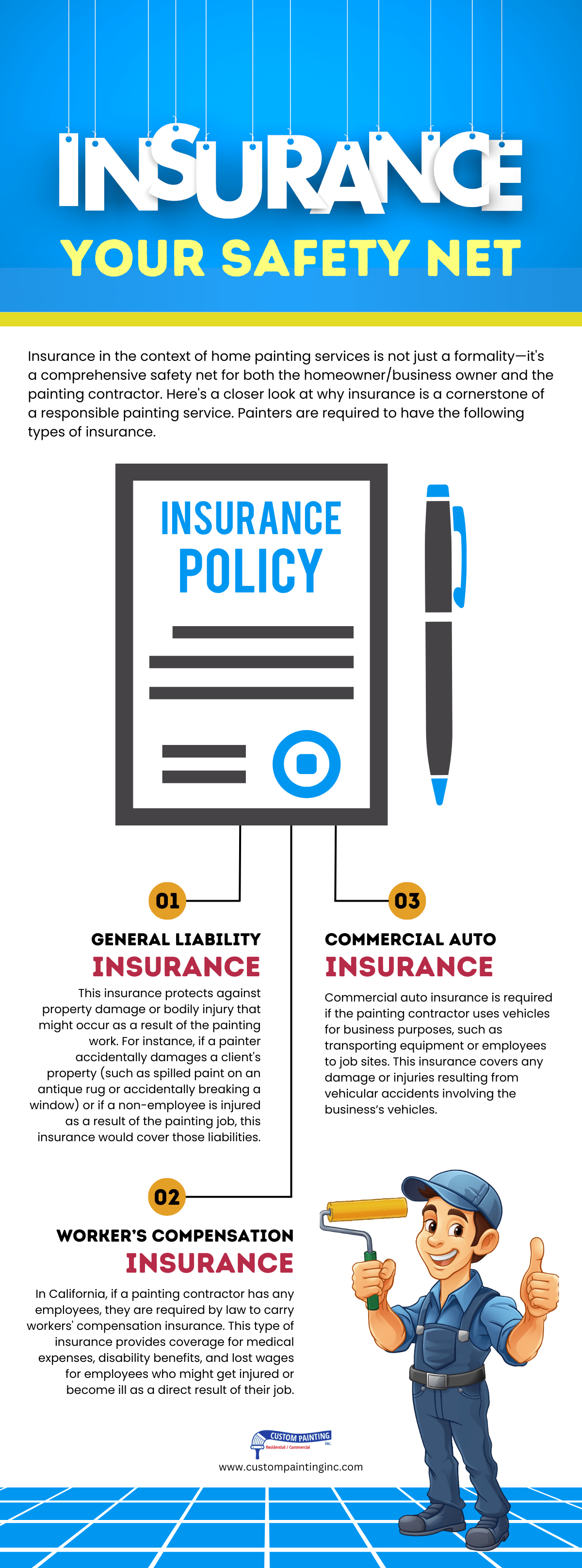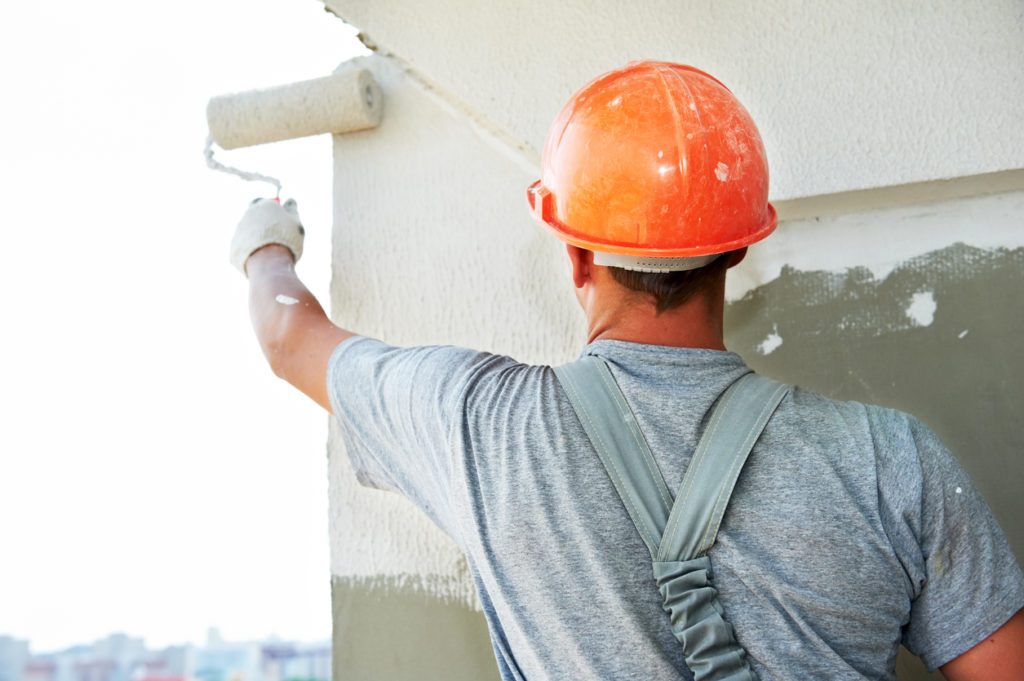Hiring licensed, bonded, and insured painting companies provides home and business owners with a level of security and professionalism that is essential for any construction or renovation project. Firstly, a licensed painter ensures adherence to state regulations and industry standards. In California, for instance, painters are required to obtain a C-33 license for any job over $500. The license verifies their professional skill and knowledge. This licensing process typically involves passing an exam and meeting certain experience requirements, which helps ensure the painter’s competence and reliability. Furthermore, licensing often requires painters to stay updated with the latest industry practices and safety protocols, contributing to higher quality and safer work.
The significance of hiring bonded and insured painters cannot be overstated. A bond acts as a financial safeguard for the property owner, offering a form of compensation if the contractor fails to fulfill the contract terms, such as not completing the job or delivering substandard work. It provides recourse for the homeowner or business owner in case of contractual disputes or failures. Insurance, on the other hand, is crucial for liability protection. General liability insurance protects against property damage or injuries that might occur during the painting project, shielding the property owner from potential costly claims. Workers’ compensation insurance, a requirement for painting companies with employees, protects the workers and the property owner in case of work-related injuries, ensuring that any medical costs or liabilities are not transferred to the property owner. Collectively, these measures assure a high level of professionalism, reduce the risk of unexpected costs and liabilities, and ensure that the work adheres to legal and industry standards, making it imperative for property owners to opt for licensed, bonded, and insured painting companies.
What Does it Mean to be Licensed, Insured, and Bonded?
As stated above, if you plan to do painting at your home or business, and you expect the project to cost more than $500, you want to hire licensed, bonded, and insured contractors. To do otherwise may cost you money and time that you may not have to spend.
Licensing
Being licensed as a painting contractor in California means that the individual or company has been officially recognized and authorized by the California State Licensing Board (CSLB) to perform painting and decorating work. Here’s what the licensure entails:
Applicants must demonstrate a certain level of experience to qualify for licensure. In California, this typically means having at least four years of journey-level experience. The CSLB also requires applicants to pass two exams: one covering law and business, and the other specific to painting and decorating (C-33 classification). These exams evaluate the applicant’s knowledge of the trade, including technical aspects, safety regulations, and legal matters. The Licensing Board also conducts a background check on applicants. This process ensures that the contractor is trustworthy and has a record clear of relevant criminal activities.
Licensed painting contractors in California must also secure a contractor’s bond. This bond protects consumers, whether home or business, by providing financial recourse in case the contractor fails to complete a job as agreed or engages in unethical business practices.
Having insurance is not a licensing requirement, but most professional painting contractors also carry liability and workers’ compensation insurance. This insurance protects clients from liability in case of accidents or injuries occurring on their property during the painting project.
Licensed contractors are expected to adhere to a set of standards and regulations, ensuring high-quality workmanship and ethical business practices. This includes compliance with state building codes and environmental regulations. They may also be required to participate in continuing education to keep their knowledge and skills up to date with the latest industry developments and changes in laws.
Finally, a painting contractor’s license is not permanent. They must renew it every two years. They must also maintain their bond and demonstrate they comply with any changes in regulations to renew their license.
A licensed painting contractor in California is a professional who has met all state requirements to offer painting services legally. This licensure serves as a reassurance of quality, reliability, and accountability to clients seeking painting services.
Insurance
Being an insured painter means that the individual or painting company has obtained insurance policies to protect against specific risks associated with painting jobs. This insurance is crucial for both the painter and the client, as it provides financial protection against potential damage, accidents, or liabilities that could occur during a painting project. Here’s what being an insured painter typically entails:
Liability Insurance
General Liability Insurance is the most common type of insurance for painters. It covers damage that may occur to the property being painted or injuries to third parties as a result of the work being done. For example, if a non-employee is injured due to the painter’s equipment being in the way, this type of insurance would cover any associated costs.
Workers’ Compensation Insurance
This type of insurance is important for the painting company if they employ others. It is typically required. This insurance will cover medical expenses and lost wages if an employee is injured while they are working. Since painting often requires working at heights and with potentially hazardous materials, this insurance is critical.
Commercial Auto Insurance
Most painting companies have a number of vehicles used for doing business. Estimators may have a company car to visit potential clients. Painting crews may use one or more vehicles, depending upon the size of the project, to carry paint, tools, and anything else to complete the job. If the painter uses a vehicle for business purposes, commercial auto insurance is necessary. This covers vehicle-related accidents during work activities.
Umbrella Insurance Some painters may opt for umbrella insurance for additional coverage beyond the limits of their standard policies. This type of insurance is important to have particularly if the projects the company works on are large or complicated.
Why Having Insurance Is Importance for Clients
- Hiring an insured painter mitigates the risk for the client. In case of damage or accidents to the client’s property, the insurance covers the costs, so the client does not have to bear them.
- Insured painters are often perceived as more professional and dependable. Insurance coverage is a sign that a painter takes their business seriously and is prepared for unforeseen events.
- In some areas, carrying certain types of insurance is a legal requirement for operating a painting business.
Why Having Insurance Is Important for Painters
- Insurance protects painters from potentially crippling financial liabilities that could arise from accidents or damage during a project.
- Being insured enhances a painter’s reputation, building trust with clients and potentially leading to more business opportunities.
In summary, an insured painter is equipped with specific insurance policies to safeguard against the inherent risks of painting work. This not only provides a safety net for the painter but also offers peace of mind and financial protection to their clients.
Bonding
A bonded painter has obtained the necessary surety bond required by the CSLB. This is a type of financial protection for their clients. A surety bond is a legal agreement involving three parties: the contractor, the client, and the company providing the bond. This bond serves as a safeguard for clients, ensuring that the painter will fulfill their contractual obligations and adhere to certain standards of quality and professionalism. Here’s what being bonded entails:
Protection Against Incomplete or Substandard Work
– If a bonded painter fails to complete a job as agreed, or if the work is substandard, the client can file a claim against the bond.
– The surety company will investigate the claim, and if it’s valid, they will compensate the client up to the bond’s total value.
– The painter is then typically required to reimburse the surety company for this payout. A new bond is purchased to remain in business.
Compliance with Regulations
– In many regions, obtaining a bond is part of the licensing process for painters. It demonstrates compliance with local business regulations.
– The bond assures clients that the painter is not only licensed but also financially backed to guarantee contract fulfillment.
Enhancing Trust and Credibility
– Being bonded adds a level of trust and credibility to a painting business. It shows potential clients that the painter is responsible and has taken steps to protect their customers.
– Clients are more likely to hire bonded painters, knowing that there is protection in place should the project not go as planned.
Risk Management for Painters
– For painters, a bond is a form of risk management. It helps them assure clients of their commitment to delivering as promised.
– The bond can also protect the painter from disputes and claims that could otherwise financially strain their business.
Building Professional Reputation
– Bonded painters are often seen as more professional and dependable compared to those who are not bonded.
– This status can be a differentiator in a competitive market, helping to attract more clients and higher-value projects.
In summary, being bonded provides an additional layer of financial assurance and protection for clients. It signifies that the painter has mechanisms in place to guarantee their performance and adherence to contractual obligations, enhancing their professionalism and trustworthiness in the market.
Additional Benefits of Working with Qualified Painters
The qualifications of licensed painters, such as rigorous training, adherence to industry standards, and a deep understanding of materials and techniques, often translate into higher quality work and the use of superior materials. Licensed painters have undergone a comprehensive vetting process, including examinations and verification of experience, ensuring they possess the necessary expertise and knowledge. This background equips them with a thorough understanding of various paint types, primers, and finishes, enabling them to select the best materials for durability and aesthetics specific to each project. Their familiarity with the latest trends and technologies in paint and coatings also means they can offer clients advanced solutions that unlicensed painters may not be aware of.
Furthermore, their commitment to professionalism and reputation often leads to a greater attention to detail in their work. Licensed painters understand the importance of thorough surface preparation, a critical step for ensuring the longevity and appearance of the paint job. They are more likely to follow best practices in application techniques, ensuring even coverage and a flawless finish. Adherence to safety and environmental regulations is another aspect where their qualifications stand out, ensuring that their work is not only visually pleasing but also compliant with legal standards. Overall, the investment in hiring a licensed painter often pays off in the form of a high-quality, durable, and aesthetically pleasing paint job, reflecting their professional acumen and dedication to excellence.
Verifying a Painter’s Credentials
Verifying a painting contractor involves a multi-step process to ensure they are qualified, dependable, and legally compliant. The first and most crucial step is to check their licensing status. In California, professional painters are required to hold a valid contractor’s license for any job exceeding a certain value. This can typically be verified through the California State Licensing Board (CSLB) for California-based painters. Their online portal allows you to check the validity of the license, any recorded disciplinary actions, and the history of the contractor. Additionally, it’s important to ask for proof of insurance, including general liability and workers’ compensation insurance. This protects you from being liable for any accidents or damage that occur during the job.
Further, inquire about bonding. A bonded painter has a surety bond that offers financial protection in case they fail to complete the job satisfactorily or breach the contract terms. Verify the bond status either through the licensing board’s website or by asking the contractor for bond details and confirming with the issuing agency. Besides these formal checks, it’s also beneficial to assess the contractor’s reputation. Look for online reviews, ask for references from past clients, and check if there are any unresolved complaints filed against them with consumer protection agencies like the Better Business Bureau (BBB). All these steps combined provide a comprehensive understanding of the contractor’s professional credibility, legal compliance, and the quality of work you can expect from them.
Potential Risks of Not Using Licensed, Insured, and Bonded Painters
Hiring non-licensed painters poses significant risks that can impact both the quality of the painting project and the legal and financial security of the homeowner or business owner. One of the primary risks is the potential for substandard work. Non-licensed painters may not possess the required expertise, experience, and training that licensed professionals do. This lack can result in mediocre quality work. This includes improper surface preparation, use of low-quality materials, and inadequate painting techniques, leading to a finish that may not last and could require costly repairs or redoing. Furthermore, without the oversight of a professional licensing body, there is little to no recourse for homeowners if the work does not meet their expectations or if the contractor fails to complete the job.
Additionally, hiring non-licensed painters can expose property owners to considerable legal and financial liabilities. In many areas, conducting certain types of painting work without a license is illegal, and the property owner could be held responsible for employing unlicensed workers. Moreover, non-licensed painters often lack essential insurance coverages such as liability insurance and workers’ compensation. This means that if an accident or injury occurs on the job, the property owner could be held liable for medical bills and other associated costs. There’s also a higher risk of fraudulent practices and scams with non-licensed contractors, as they might not adhere to contractual agreements, leading to issues like taking payments without completing the work. Overall, while the lower upfront cost of hiring a non-licensed painter might seem appealing, the potential risks and long-term financial implications make it a risky choice.
Conclusion
Many homeowners and business owners want to save money when they need to have painting done on their property. They may think that hiring a contractor with a lower estimate (often meaning they are not properly licensed or insured) will cost less. The opposite is more than likely to be the case. They may end up needing to have portions, or all, of the work redone. There may be an injury to their property which they are financially liable to pay for, or the property may be damaged or stolen. By hiring a licensed, insured, and bonded painting company, the property owner can know the company will do the job they are contracted to do, they will not be responsible for any potential injuries, and the job will be completed to their satisfaction.
Call Custom Painting, Inc. to discuss any future painting projects you have planned. You can reach them at 510-795-0903 or complete the form on the website. Someone will it and you to learn more about the project and set up an appointment for the estimator to visit your property, walk through it, and provide you with a free estimate for the project.





